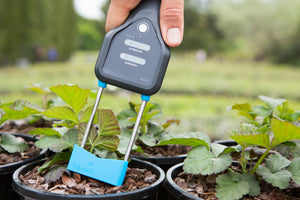
4 TYPES OF HYDROPONIC SYSTEMS
Ebb and Flow
These types of systems are often called flood and drain. The plants are usually grown in pots with their roots supported by a growing medium. The pots sit in a plastic tray which in turn sits above a reservoir of nutrient solution. Since the system relies on gravity to do the work, the growing tray must be higher than the reservoir. A pump in the reservoir is connected to the bottom of the tray. When the pump turns on, the tray fills with water. When the pump turns off, the water runs back down through the pump into the reservoir. Poetry...It is an Ebb and a Flow. A breathing in and breathing out rhythm that aerates your plants in diligent meditative cycles. Listen closely, through the bubbling water, you may hear your plants quietly saying “Om.”
An overflow fitting is added in the tray to regulate the depth of the water. When the water level reaches the top of the fitting, the water falls back into the reservoir. The irrigation cycle is controlled with a timer. A typical schedule would involve several short (30 to 45 minute) cycles per day, but the duration and frequency of cycles varies from one system to another and are dependent on the crop, the plant size, and the conditions. The average is 3 to 4 times during the 12/12 (light/dark) bloom phase and 4 to 6 times during the 18/6 (light/dark) vegetative phase. The ebb & flow method supplies plenty of fresh oxygen to the root system of plants - first, as the tray is flooded with solution, air is pushed out from around the root system. When the pump is turned off, the tray drains and oxygen rich air is drawn down to the roots.
About NFT
Nutrient film technique hydroponic systems are some of the most productive available. They are often the chosen method of commercial growing. Plant roots are grown in a light-tight and shallow channel. Nutrient solution is continuously circulated, flowing over the roots up to 24 hours per day. The name of this growing method was coined to stress the shallow depth of the liquid flowing past the roots. This is vital to ensure that sufficient oxygen is supplied to the plants. A wide range of vegetables and ornamental crops can be grown in an NFT system.
Aeroponic Systems
Aeroponics is an exciting improvement on hydroponics. Plant roots are suspended in the air and misted by high pressure sprayers which break nutrient into small particles and saturate the roots. The roots are grown in a misty, humid environment, with minimal grow media. Due the water’s constant circulation and the action of a high pressure pump, the levels of oxygen in the water are kept high. According to UC Davis researchers, aeroponics increases plant growth rate by as much as 50 percent. You can see this working in places like Hawaii where orchids are often seen growing freely in the trees. Aeroponics is space age, futuristic stuff and aeroponic techniques are being investigated by NASA.
About Drip Systems
Drip systems are the most widely used hydroponic systems in the world and our personal favorite. They provide plenty of aeration because plant roots are never totally submerged, but are never allowed to dry out. Drip systems also pull oxygen down with the water emitted from the drippers. This oxygen rich water trickles over the plant roots and nourishes them. Operation is simple, a pump has tubing connected to it which branches off to feed many plants. Nutrient solution is dripped at the base of each plant where it trickles through grow media and into the roots, finally draining into the reservoir where it is reused or drained to waste. Depending on the medium used, a timer is to be set appropriately. Drip systems can be set for “Drain to Waste” as well. Please see Info sheet on “Drain to Waste.”
In the system below, four main lines break off the main pump line. Each line has a compression end cap at the termination point. The lines are connected to each other using ½” tees which allow for sharp turns and prevent the tubing from kinking. The lines have drip rings attached, one, or two for each plant. Alternatives include ¼”1-1 connectors or GPH drippers. (Drip Rings are made up of ¼”Tees every few inches along the drip circle. Connect to the main line w a ¼” Tee as well.)
